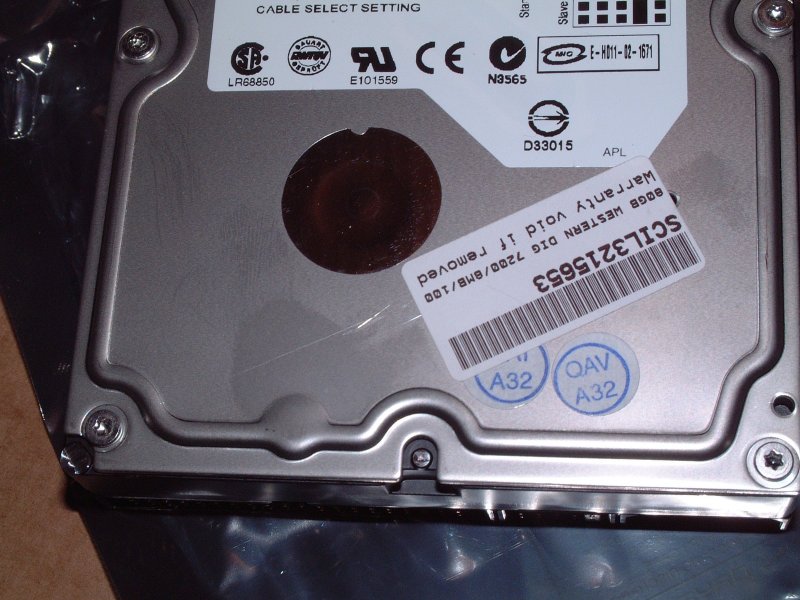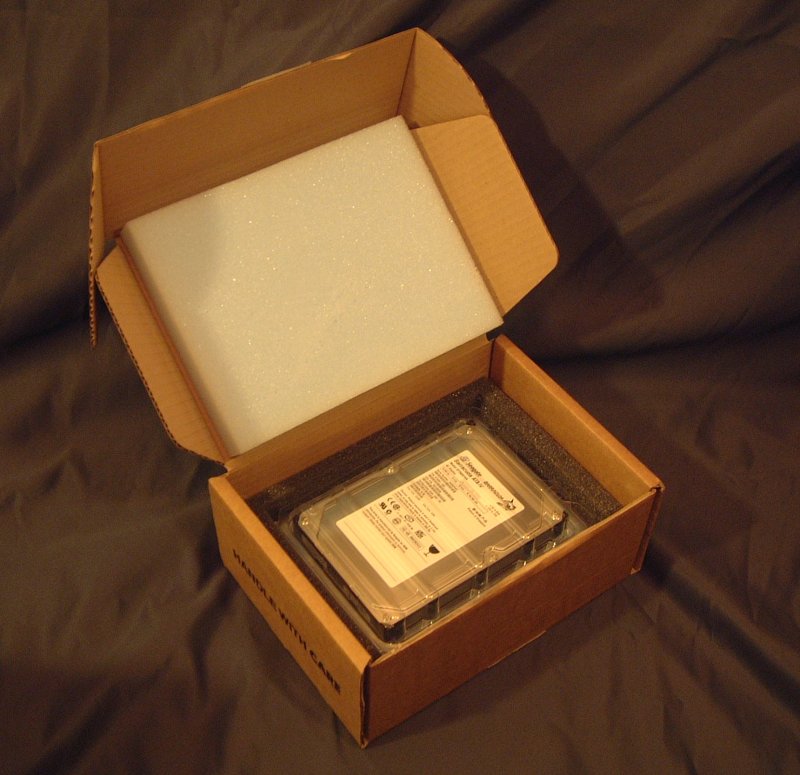Having given up on ibm's hard drives which have consistently failed on me before their 2nd birthday, I ordered a lovely new Western Dig 80GB drive...
here it is:

Straight out of the box from Scan, having discarded the acres of bubblewrap.
"Hold on a moment... that antistatic bag has been opened... That's not proper" flashed through my mind, along with "is this a reconditioned drive? Have I been given a drive that someone else has returned for some reason?"
At this point, a little aside:
Antistatic bags of this type are a layer of aluminium foil enclosed by plastic. Their purpose is to create a Faraday shield around the device you're protecting. The effect is that it is practically impossible to create an electrical potential difference of significant magnitude across the hard drive while it is in the bag. Now consider the bag is not intact. Further, consider that part of the hard drive is in contact with the acres of bubble wrap surrounding the drive. Bubble wrap is not conductive, and there's no reason why a static potential of around 20kV might not exist on the bubblewrap. My opening the package, and pulling back the packing tape from the bubblewrap would certainly have generated an appreciable voltage - even wearing an antistatic wriststrap, and on a conductive mat. Since the hard drive is no longer fully protected by the bag, who's to tell what voltage it has experienced. What's more, exposure to high voltages doesn't always cause an immediately failure of a device, it might just have shortened the life of my hard drive by 20,000 hours. Then again it might not have caused any damage at all. Once a device has been exposed to the risk, the only way to analyse the damage (if there are no overt signs of it) is to take the semiconductors out of their plastic packages, and take a very close look (close like scanning electron micrography). See http://www.wallash.com/datastorage.pdf if you're interested in more detail. (I'm an electronic engineer with a Master's degree, understanding ESD is part of my job.)
A closer look, and I discover why the bag has been opened. I am supposing that Scan had decided that they wanted to affix a label to my hard drive with an identification number. Why they couldn't just have read the serial number of the drive through the bag, I don't know.

What's that bit of Writing in the yellow patch at the top of the drive? "DO NOT COVER ANY DRIVE HOLES" well, ok, I'll try to remember that. It seems fairly simple.
What's that just peeking out from under Scan's SCIL label? Let's take a closer look:

Oh... its a hole. Isn't that the breather hole for the hard drive? What did that Yellow thing say again...? That was the hole that the yellow warning was desgined to protect wasn't it? Does that invalidate the drive warranty? How about if I peel back the label - interfering with Scan's ID label is probably sufficient cause for them to refuse to honour my warranty... In the words of Bart, "Well, you're damned if you do, and you're damned if you don't." .
What's that catching the light just left of the label? Looks like a scratch... Like perhaps from someone opening the antistatic bag with a knife, and not being careful about what they're doing. Oh, that's right, the bag was already open, wasn't it... lets go back to the first picture. Yes, that looks like the scratch is right where the bag had been opened. Lets have another look at that sticker position... right on top of the scratch.
Well, that seems fairly conclusive to me. What do you think?
Addendum 04/09/2002
Seagate have a fairly good (and not very confusing) proper handling guide on their website.
http://www.seagate.com/training/properhandling/munitintro.html
It introduces the concepts of mechanical damage to disk suface and bearings. It mentions ESD, but doesn't go into enough
depth on how the damage occurs, and what damage is caused (imho, but remember I'm an electronics geek)
However, I was delighted by these statements:

And now I've found a similar document on the Western Dig site:
http://www.wdc.com/library/dhg.pdf
I feel that Scan should note:
[page 9]"Western Digital hard drives have one to four small air filter holes on either the top or side of the drive enclosure. Do not obstruct or cover these holes with items such as stickers".